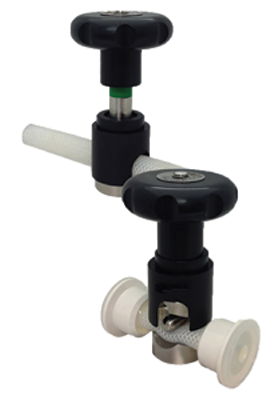Pinch Valves: An Uncomplicated Valve with an Important Purpose
Pinch valves are a simple valve design that uses an elastomeric tube forced together or pinched to stop the flow of media.
Pinch valves are used in on/off applications as well as throttling services. The applications where this is useful range from clean or sanitary services such as the chemical, food and pharmaceutical industries to more industrial services such as wastewater, the cement industry and where there is flow of bulk solids. Pinch valves are used in sanitary services because of their cleanliness and drainage, while they are used in more industrial services because of their low friction and resistance to clogging. They do well in these services compared to other more common valve types such as butterfly, ball and globe valves because, along with their aforementioned merits, their simplicity makes them simple and cost effective.
PINCH VALVE STYLES
The different types of pinch valves can be described broadly as two types: those where the sleeve is integral to the body and those where a separate clamp is used to pinch a tube or a hose closed.
Integral Sleeve
Pinch valves are generally very low maintenance. However, since they rely on an elastomeric tube or hose that is forced or clamped to restrict or stop flow, the tube or hose is where the majority of the maintenance is required. When the sleeve, tube or hose becomes worn or damaged from use, it must be replaced. Meanwhile, the valve body components, since they are isolated from valve media, require little maintenance.
Pinch valve components can be made from a variety of different materials depending on the severity of the service and the media that flows through the valve. The sleeve, tube and hose can be made from neoprene, natural rubbers, silicone, EPDM (ethylene propylene diene monomer rubber, extremely durable synthetic rubber membrane that has a higher heat resistance than natural rubbers), FKM (fluoroelastomer, which has more heat and chemical resistance than nitrile or neoprene), and many other elastomers, while the body of the valve can be made from plastics, stainless steel, aluminum and other metals depending on the service of the valve.
Integral sleeve-style pinch valves are chosen when the media can be corrosive or it contains solids or abrasives. This is because there is minimal friction within the sleeve of the pinch valve so it is resistant to clogging. These valves also may be chosen when minimal turbulence is required or in cases where excellent drainage is necessary. Pinch valves are also an excellent choice when media exposure to non-elastomeric materials can be an issue such as when the media is corrosive to metals.
Clamp Style
Since the clamp style of pinch valve is separate from the tubing or hose that it closes off, the valve itself has very minimal maintenance. This style of pinch valve is generally made from metallic materials such as stainless steel or aluminum, with handles made from plastics to help reduce weight. In some cases, this style of pinch valve can be made entirely from plastic to reduce cost and weight. However, doing so creates a more limited ability and life span.
Clamp-style pinch valves are chosen for services that require a valve that can be installed with no process break. They are generally installed on single-use disposable systems, in pharmaceutical manufacturing, and in food and beverage applications that use flexible or braided tubing.
CONCLUSION
Although pinch valves have a simple design and purpose, they are used for a wide variety of applications. Knowing their purpose and how they work allows those who choose them to pick the right type.
COREY P. CHURILLA is senior mechanical engineer, Research and Development, PBM Valve Solutions. Reach him at cchurilla@pbmvalve.com.
RELATED CONTENT
-
Regulators versus Control Valves: What’s the Best Fit?
The combination of North American shale fields that continue to fuel high levels of new domestic oil and gas projects and ongoing global efforts means the need for efficiency in instrumentation selection has never been higher.
-
Creating a Standard for Severe Service Valves
Severe service valves are offered in several standard designs, including non-return, isolation and control types.
-
An Overview of ASME B16.34-2017
The content of American Society of Mechanical Engineers (ASME) Standard B16.34 is essential to those who deal with flanged, threaded and welded-end valves.









 Unloading large gate valve.jpg;maxWidth=214)


